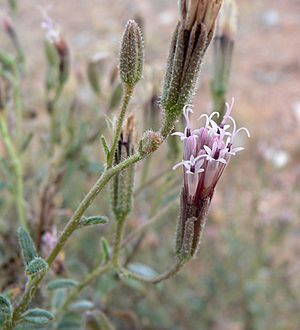Palafox facts for kids
Quick facts for kids Palafox |
|
|---|---|
 |
|
| Palafoxia arida | |
| Scientific classification | |
| Kingdom: | |
| (unranked): | |
| (unranked): | |
| (unranked): | |
| Order: | |
| Family: | |
| Subfamily: |
Asteroideae
|
| Tribe: |
Bahieae
|
| Subtribe: |
Carduinae
|
| Genus: |
Palafoxia
Lag.
|
| Synonyms | |
|
|
Palafoxia (also called palafox) is a group of flowering plants found in North America. These plants belong to the sunflower family. They are part of a smaller group called the Bahia tribe.
Contents
What is Palafoxia?
Palafoxia plants are usually herbs that live for one year. They are very good at surviving in dry places. You can find them in sandy areas, deserts, and grasslands. They grow naturally in the United States and Mexico. One type, P. callosa, has also started growing in Hawaii.
Why the Name Palafoxia?
The name Palafoxia comes from a Spanish hero. He was named José de Palafox y Melzi (1776–1847). He was a captain-general who fought against Napoleon's armies.
How Palafoxia Plants Grow
These plants have a straight, thin stem. It usually grows about 30 to 60 centimeters (1 to 2 feet) tall. The stem branches out near the bottom. The upper parts of the stem can be a bit hairy and sticky.
Leaves and Flowers
The leaves of Palafoxia plants are smooth and sticky. They are shaped like a spearhead, about 3 to 20 millimeters wide and 4 to 7.5 centimeters long. The leaves grow one after another along the stem.
You'll see a few flower heads at the end of the plant's upper branches. The flowers are often reddish to pink. Each flower has three thin petals. Small leaf-like parts called bracts grow under the flowers.
Seeds and Reproduction
After the flowers, the plant makes small, narrow, seed-like fruit. These fruits have several pointed scales. This is why one type, P. arida, is sometimes called 'Spanish Needles'. These plants can easily spread their own seeds.
Importance of Palafoxia
Palafoxia plants are important for many animals. They attract bees, butterflies, and birds. They also serve as food for the young (called larvae) of some Lepidoptera (moths and butterflies). For example, the larvae of Schinia niveicosta only eat P. linearis plants.
Traditional Uses
Some types of Palafoxia have been used in folk medicine. For instance, Rosy Palafox (Palafoxia rosea) was used to help with fever, nausea, and chills.
Types of Palafoxia
There are several different kinds of Palafoxia plants. Here are some of them:
- Palafoxia arida: Also known as Spanish Needles or Desert Palafox. Found in Baja California Sur, Sonora, California, Arizona, Nevada, and Utah.
- Palafoxia callosa: Called Small Palafox. Grows in Coahuila, Texas, Louisiana, Mississippi, Arkansas, Missouri, and Oklahoma.
- Palafoxia hookeriana: Known as Sand Palafox. Found in Texas.
- Palafoxia integrifolia: Called Coastalplain Palafox. Grows in Florida and Georgia.
- Palafoxia lindenii: Found in Veracruz, Mexico.
- Palafoxia linearis: Grows in Baja California Sur, Sonora, Sinaloa, Chihuahua, and California.
- Palafoxia reverchonii: Known as Reverchon's Palafox. Found in Texas.
- Palafoxia riograndensis: Called Rio Grande Palafox. Grows in Coahuila and the Big Bend area of Texas.
- Palafoxia rosea: Known as Rosy Palafox. Found in Nuevo León, Mexico.
- Palafoxia sphacelata: Also called Showy Palafox or Rotting Palafox. Found in Chihuahua, Veracruz, Texas, New Mexico, Oklahoma, Kansas, Nebraska, and Colorado.
- Palafoxia texana: Known as Texas Palafox. Grows in Nuevo León, Coahuila, Tamaulipas, Veracruz, Texas, Louisiana, and Florida.
See also
 In Spanish: Palafoxia para niños
In Spanish: Palafoxia para niños

